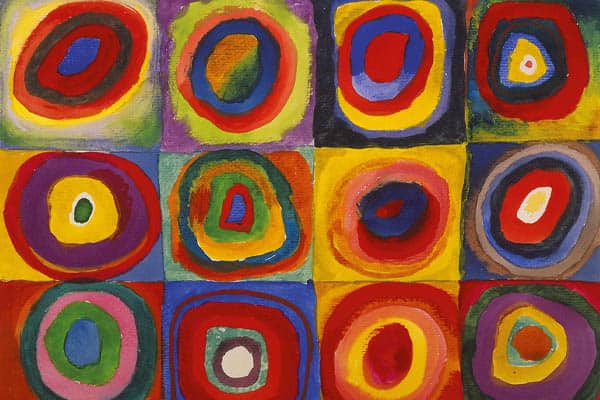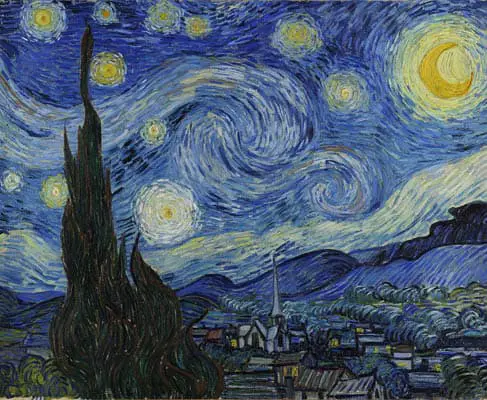Shape is one of the seven elements of art. They are the building block of every artwork. Without shapes, you won’t get very far in creating a piece of art. Shapes are not only helpful for people who create art, but also for the audience to help them understand an artwork!
Shapes are two-dimensional objects that have a height and a width. They are created by lines that intersect or overlap one-another. Shapes are the building blocks for all artworks and can be classified as geometric or organic.
In this article, we will take a look at the different kinds of shapes using in art. This includes geometric shapes and organic shapes. We will then discuss how and why shapes are used in art.
Alrighty, put on your shape pants and let’s begin!
What’s the Difference Between Organic and Geometric Shapes?
Geometric shapes include circles, squares and triangles. Whereas organic shapes are curvilinear and unpredictable – they include all shapes found in nature.
Geometric Shapes – What Are They?
Geometric shapes are two-dimensional objects that have a mathematical (and often symmetrical) structure to them. Geometric shapes are created by lines intersecting at particular angles and lengths.
Geometric shapes are often associated with things that are man made. Think of a wheel (circle), a roof (triangle) and a door (rectangle). If you’re on a busy city street, you’ll find geometric shapes everywhere you look.
Geometric shapes can be any polygon or ellipse, but to keep things simple (and to not bore you to tears), we’re gonna focus on the big three – circles, triangles and squares!
Circles
As you may already know. Circles are those round things you keep seeing everywhere. They are a continuous line that have no angles – just a smooooth curve with no beginning and no end.
What Do Circles Symbolize in Art?
Circles can symbolize life, unity, focus, movement and perfection. They are perfectly round, but in the art world, circles are often painted as a derivative of a circle (kinda roundish, but still circular).
Let’s take a look at one of the most famous circles – the Chinese symbol Yin and Yang (Yīnyáng for those who love a bit of Pīnyīn). This ancient symbol is clearly more than just an image, nevertheless it is an artwork worth talking about.
Its black and white design symbolizes complementary forces that fit perfectly together. It is made up of two parts (the black and the white), but together it symbolizes the many natural dualities in life. Light and dark, male and female, fire and water, and many more.
What about Wassily Kandinsky and his love of circles? Circles can often symbolize focus. Kandinsky’s famous painting Squares With Concentric Circles show an array of squares with multicolored concentric circles in each square.
Each circle has its own focus, drawing the viewer into each one. Staring at each colorful dot in the center is beautifully complemented with the other colors in the periphery.
This painting was originally just a little fun study… but things clearly got a bit out of hand, because it is now one of the most famous abstract paintings in existence.
Circles can symbolize movement. Take a look at Vincent van Gogh’s The Starry Night. The circular motion of the clouds, the circles emanating from the stars. Even the crescent moon looks like its got movement.
The sky is made up of still brushstrokes, frozen in time. But still, there is nothing still about The Starry Night’s sky!
Triangles
Triangles are any three-sided polygon: They can be Equilateral, Isosceles or (the wonderfully random) Scalene. They are great to use in art because of the interesting shapes and angles they produce.
What Do Triangles Symbolize in Art?
Triangles symbolize strength, hierarchy, direction and stability.
Artists often use triangular compositions to create a more interesting and engaging image. This is particularly popular in some of the world’s most famous paintings.
Think of the Mona Lisa, put a party hat on her, squint your eyes and she becomes a triangle. So if the most famous painting in modern history uses triangles, you know it’s gotta be good.
If you look at any renaissance painting depicting the Virgin Mary with Jesus, they will often have a triangular composition as well. In religious symbolism, triangles are often used to convey direction. A triangle is one big arrow, pointing upwards in the direction of the heavens, where there is something greater than our earthly existence.
One could argue that all pantings of humans would follow a triangular format, but if you look closer, the artist is making a deliberate choice.
In the two paintings above, both subjects have their arms at a certain angle, with their elbows pointing outwards. These types of poses are often used in art and are used to further enhance the triangular composition.
Squares (and Rectangles)
A square is a polygon with four equal straight sides and 90 degree angles. And if you increase or decrease the lengths of two opposite sides, you’ll get yourself nice rectangle!
What Do Squares Symbolize in Art?
Squares symbolize structure, stability, abstraction and simplicity in art. Let’s start with the canvas itself – just think of all the artworks on walls. They all need structure and stability to hang there – and more than 99% of artworks are squares or rectangles.
Now what about squares in the actual artworks? Think of some famous paintings with squares in them. The first ones that come to my mind are Piet Mondrian’s later works and AAAANYTHING by Mark Rothko!
Piet Mondrian’s earlier works are beautifully painted impressionistic landscapes. But once we roll around to 1920, it’s BAM! SQUARES baby!!!
Although Mondrian understood form and perspective, his new paintings were a heavy abstraction of anything seen in the real world. Even the colors were abstracted down to the primaries – red, yellow and blue.
One of the things I love about Mark Rothko’s paintings is that they are heavily dependent on the physical spaces they were painted on.
Rothko’s rectangles show great stability by running along the width of the canvas (while leaving some background space between the rectangles and the ends of the canvas).
This representation of simplicity makes Rothko’s paintings both pleasing and easy to look at.
Why Do Artists Use Geometric Shapes?
Artists use geometric shapes because they act as the building block for more complex, detailed shapes. Having a basic, geometric shape as a foundation, will give the artist a starting point to allow them to refine it into something a little more fancy!
All objects, either natural or man made, can be broken down into geometric shapes.
(think of the pixels on the screen that you are looking at – it’s just a bunch of very well organized, tiny squares making an image!)
What Are Organic Shapes?
Organic shapes are two-dimensional objects with no defined structure assigned to them. They are made up of curvilinear and unique, random lines and are often used to describe things from the natural world.
In the previous section, I mentioned that geometric shapes can be found everywhere on a busy city street. But if you were to hop into the nearest time machine and go back a million years, you will struggle to find any geometric shapes. This is because your fellow humans haven’t arrived yet with their circular wheels and rectangular buildings!
Instead, you’re gonna find 100% organic shapes. Every tree trunk, every imperfect leaf and every unique rock.
What are Examples of Organic Shape in Art?
Examples of organic shapes in art include anything from the natural world: people, plants, landscapes and clouds. Organic shapes can be anything abstract and fictitious as well. You can even describe Jackson Pollock’s paint splatters as being organic shapes.
A good method when learning to draw organic things, is to think of them as having building blocks based on geometric shapes.
This can work with planning a sketch, a painting and even video games. Again – think of pixels! For example: Nintendo games back in the 90’s. All of the characters, items, backgrounds and scenery were made up of those little squares called pixels.
How Can Shapes Be Used to Build an Image
Artists can either:
- Start with a shape and build on it
- Start with a shape and sculpt away from it
Either way, shapes are the starting point for an artwork.
When starting an artwork, one very important technique artists use is to go from “general to specific”.
This means that they start designing their composition using the simplest overall shape of their subject. From there, they will refine it down using smaller, more detailed shapes.
Without shapes, putting together an artwork would be a pretty tricky job!
Why is Shape Important in Art?
Shape is important in art because it gives an artwork structure. It is impossible to have an artwork without shape (And yes, even a square canvas covered in red paint will have a square shape).
Humans are drawn to shapes. We learn about squares, circles and triangles from an early age and we recognize them in all kinds of things – furniture, buildings, jewellery and so on.
A shape, whether obvious or implicit, will make the artwork more appealing to the viewer.
The shape of an artwork will also make it or break it. If the shapes communicate their intended message well, then the artwork is going to be more appealing to the viewer.
Conclusion!
Shapes appear in all artworks and come in different shapes and sizes. Shapes can be geometric (circles, triangles and squares) or organic (any shape with no defined structure).
Shapes are the building block for all artworks – without shapes, we would have a pretty rough time trying to see what each artwork represents!
Anyway, that’s all for today. Thanks so much for reading and I’ll catch ya next time.
Malcolm Monteith
Melbourne



